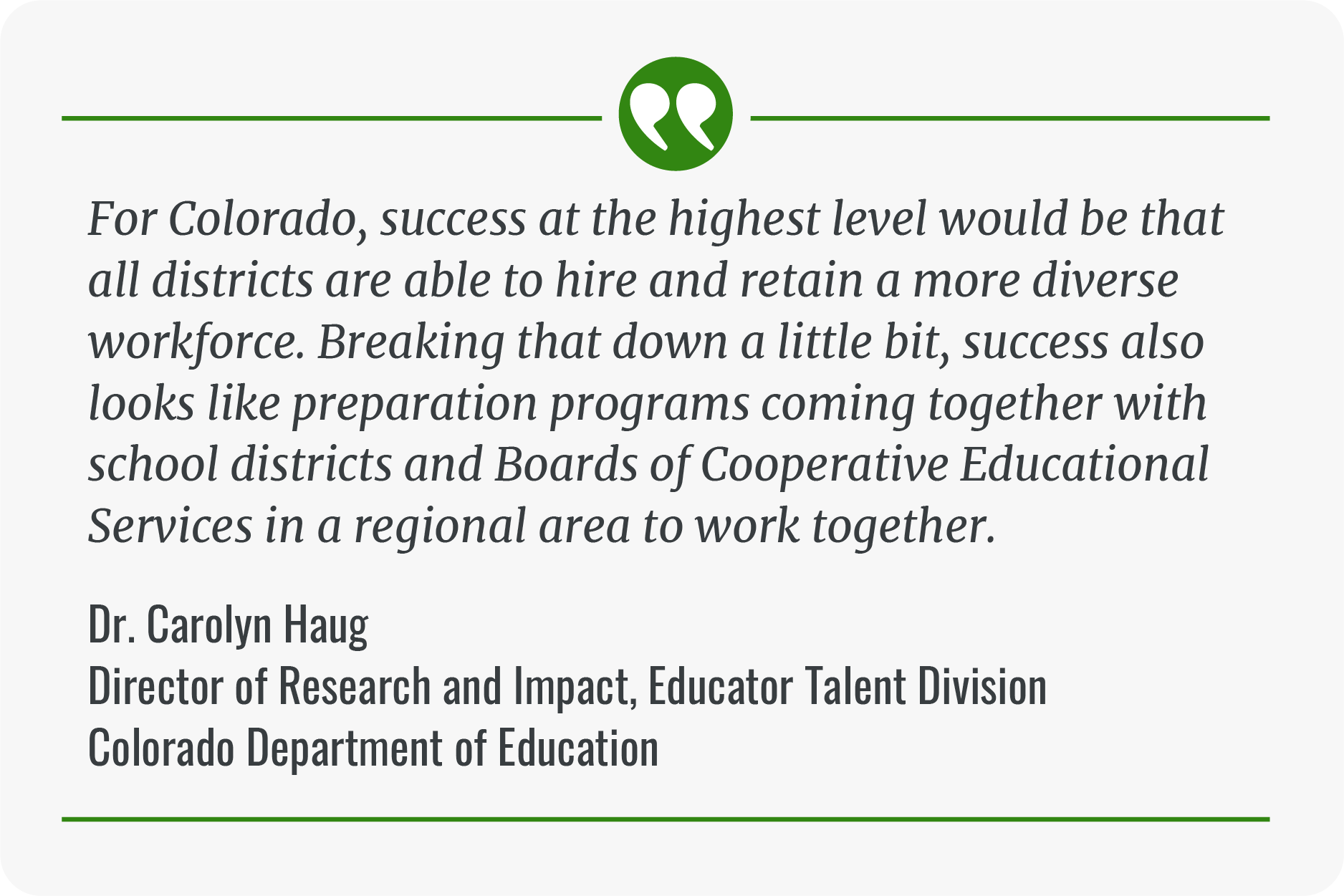Voices from the Field spotlights stakeholders in Region 12 and their work to improve educational opportunities and outcomes. R12CC is privileged to collaborate with and share the insights of Dr. Carolyn Haug, Director of Research and Impact, Educator Talent Division at the Colorado Department of Education.

What are the goals of the Using Place-Based Decision Making to Strengthen the Colorado Educator Workforce Pipeline project?
This project work dovetails very nicely with much of the work the Colorado Department of Education (CDE) is focused on related to hiring and retaining a diverse workforce. Not just racial and ethnic diversity, but also gender diversity. Also, recruitment and retention in hard to fill content areas to make sure, for example, that there are special education teachers available across the state. We know that special education has been one of our most challenging areas to fill, and many of our rural areas have multiple shortage areas.
One of the goals of this geographic information system map (GIS) project is to illuminate the complexity of districts, and how where they are located actually does matter and makes a big difference in teacher recruitment and retention. Through this project, we see these differences, especially by looking at data coming from rural versus non-rural communities. These differences likely exist across the nation, but in Colorado we also have rural, mountain communities, which are vastly different from our rural, plains communities. These rural, mountain communities are facing very different types of challenges. Some of the data that we are seeing through this process is really helping us to help other education groups understand that specific challenges in a rural ski resort town can be very different than a rural farming community on the plains. One of the goals of this project is to help us communicate about those differences, as well as urban/rural differences in general.
Another goal is around the diversity of the workforce. We look at the schools and districts that are hiring diverse educators and think about: Where are they located? Which ones are having challenges diversifying? Which of our preparation programs are producing diverse educators? And how might we use the data to match up educator preparation programs’ supply with the demand from the school districts?
This project has other components that are not specifically focused on the GIS maps. For example, there is a report where we looked at the GIS maps and we identified bright spots. Those were districts that are doing a very good job at recruiting and retaining a diverse workforce. We then conducted interviews with those district or school leaders to develop a report on their activities and initiatives.
What does success look like?
For Colorado, success at the highest level would be that all districts are able to hire and retain a more diverse workforce. Breaking that down a little bit, success also looks like preparation programs coming together with school districts and Boards of Cooperative Educational Services (BOCES) in a regional area to work together. These groups can use the data we’re providing to identify the kinds of challenges they are having, look for the root causes of those challenges, and come up with strategies to address those root causes. Our project team has been working on this part for the last six months. As we move into Year 4 of the project, we are planning to develop regional cohorts that will work together to solve problems regionally so that they will be able to hire and retain a diverse workforce.
How does this work complement/impact other initiatives at Colorado Department of Education?
This project dovetails nicely with a lot of the other work and initiatives that we have going on at CDE. The GIS maps created through this project are one of a small array of interactive data tools that we’ve developed at CDE. This project is really bringing all our data together for us. Most of our other data tools are very focused on a particular audience or a particular topic. For example, we have a data tool that is focused on an educator shortage survey that only has that data in the tool. We have another data tool focused on our educator evaluation metrics that is devoted entirely to all the details around educator evaluation. We have other tools that allow users who are really interested in a particular topic to explore data in great detail through that tool. The GIS maps bring many different data sources together—including data that come from outside CDE. I believe this is the only tool we have where we are bringing in outside data sources and users are not just diving into all the details around a particular data source, but they can pull high-level information from multiple data sources and bring those together to understand what may be influencing recruitment and retention in specific locations.
How has the project work changed over time? Is there anything that you would have done differently?
We learn from the feedback that we collect from our stakeholders, and we try to take that into consideration as we design what the coming year looks like. We have a five-year project plan, but the details of that are fluid enough that as we evolve, we can adjust. For example, one of the changes that we made this past year was to add a teachers of color and students of color dashboard to the GIS maps. This allows our stakeholders to look at districts across the state and ask: Where are our students of color? Where are our teachers of color? And how do those two things relate to each other district by district? We can now pinpoint areas of the state where we have high levels of students of color and low levels of educators of color, particularly in contrast to a nearby district who also has high levels of students of color and high levels of teachers of color. That allows us to start asking questions around, why would one district have a lot of teachers of color, and right next door, you have a district that doesn’t? We can then try to unpack that and see where those questions lead.
What recommendations would you have for someone else taking on a similar project?
Through this project, in 2021, we developed a brief that compared educator workforce shortages state-by-state. This was a national scan of what different states were doing to address educator shortages. This brief is a resource that other states, if they’re going to engage in this work, might want to look at as they plan their work. The brief helps to see what other states like their own are doing and how those states might be approaching educator shortages in a completely different way to see what could be learned from others engaging in similar work.
We have also faced challenges that others may encounter. The work to engage districts and BOCES with our resources has been particularly challenging during the pandemic. I suspect that even without the pandemic, engaging stakeholders would be challenging because they are so busy. To address this challenge, we have formed communities of practice where we bring together regional teams of people that draw from groups of stakeholders like school districts, the BOCES in the same geographic area, the educator preparation programs that serve that area, and maybe local advocacy groups, to really engage with the resources and go through the root cause analysis process.
We are also working to leverage a new set of regional specialists here in Colorado, who each have been assigned a region of the state. These specialists are focused on educator recruitment and retention, and they are living in the regions and have connections in the regions. We are engaging with them to use the maps to inform district issues and encourage districts to engage with their data in the community of practice.
Tell us about your professional role at the Colorado Department of Education and your responsibilities related to the educator workforce.
I am the Director of Research and Impact, Educator Talent, and my job is focused on providing information around the health of the educator workforce. This includes a variety of levels. My office designs data collection processes and identifies data that we need to collect. We work with the CDE data warehouse to ensure we have a place to store that data. It is a very broad responsibility, down to the very details of making sure we have fields in the data warehouse, and then working on ways to analyze and present that data so that users can make meaning of the information, and bringing groups together to use the data to resolve workforce issues.
At CDE, we try to reach multiple audiences who are involved in the educator pipeline with these data stories. We target Colorado school districts, BOCES, educator preparation programs, both the traditional ones and the alternative ones, standalone charter schools (those that may not be affiliated with a school district), other education policy offices, the Governor’s office, and the general public. We have multiple audiences, and our work is to make the information consumable to these audiences. We don’t always get it right the first time. We recently just added a feedback option to all our web pages that display data so that someone can let us know if whatever report they are looking at is not helpful to them, and we can respond. We are collecting this feedback on an ongoing basis. Because we don’t often know what format is most useful for the various user audiences, it’s helpful to understand, for example, how we designed something one way works for our educator preparation programs, but maybe doesn’t work for other stakeholders.
